- Submissions

Full Text
Novel Research in Sciences
Evidences Towards Hydrothermal Origin of Manganese Deposits of Sukli - Sitapathore - Tirodi - Ramrama - Bharweli - Ukwa Belt of Madhya Pradesh, India
Banerji DC*
Department of Geology, India
*Corresponding author: Banerji DC, Department of Geology, India
Submission: September 12, 2020;Published: November 03, 2020
.jpg)
Volume5 Issue2November, 2020
Abstract
Manganese deposits of Balaghat belt of Madhya Pradesh, India, occur as shear parallel quartz-manganese interlayers restricted within the mylonite zones of the area. The interlayered ore bodies, along with the shear planes, maintain a co-axial, non-coplanar relationship to the S1 schistosity of the country rock. They also exhibit folding along S2 and S3 axial trends and attain a sinuous map pattern. These ore bodies also show widespread felspathization of the wall rocks and pneumatolytic activity along their periphery, resulting in the development of tourmaline, apatite, chlorite, fibrolite bearing quartz-mica schists/gneisses. Dimensional orientation of the constituents of the ore bodies along ‘S’ and ‘C’ planes of the mylonites is characteristic with all the deposits, indicating ductile to brittle ductile movement along these mylonites.
It is envisaged that the rocks of the area, belonging to Sausar Group of metamorphites, were subjected to shearing during late D1 deformation. These shear zones were then occupied by hydrothermal bodies related to late D1 pink magmatism. These hydrothermal bodies were either rich in residual manganese, or scavenged manganese oxides from the manganese silicates of the country rock. The calcium rich manganese silicates ‘Gondites’ are possibly produced by interaction between the felspathic components of the hydrothermal bodies with the manganese oxides and the randomly occurring calc-silicate enclaves of biotite gneiss. The hydrothermal hypothesis towards the origin of manganese explains satisfactorily the anomalous occurrence of high temperature oxide ores with intergrowth textures in the low temperature region of Sausar metamorphites. It also explains the absence of other members of the Sausar metamorphites from the so called ‘narrow furrows of deposition’ as advocated for the biotite gneiss hosted manganese deposits.
Keywords: Mylonites; Pink magmatism; Hydrothermal emplacements; Boron metasomatism; Griesening; Gondite
Introduction
The manganese deposits of Sukli - Sitapathore - Tirodi - Ramrama - Bharweli - Ukwa belt of Balaghat district of Madhya Pradesh, India, occur as NNE- SSW to ENE - WSW trending conformable bands, within the metasedimentary sequence of Sausar Group of rocks. Based on the association and co-folding of the ore bands with the quartz-muscovite schists of Mansar Formation, these manganese-oxide deposits have been considered to be of metamorphosed syngenetic type. Fermor (1), Straczek et. al. (2), Roy (3- 9), Subramanyam (10), Shukla and Anandalwar (11) and Vemban and Nagrajaiah (12), are some of the pioneer workers supporting a sedimentary origin for these manganese deposits. It is, however, interesting to note that high temperature manganese oxide ores like hausmanite, vredenbergite, jacobsite and braunite constitute the major part of these deposits. Fermor [1] considered that these oxides have resulted either from the metamorphic alteration of the original sedimentary manganese minerals, or from the deep-seated re-oxidation of the manganese silicates (Gondite). Straczek et al. [2] suggested that deposition of manganese took place only as primary manganese-oxide (braunite), which was later metamorphically or metasomatically altered either to high temperature manganese-oxides or to manganese silicates respectively. Roy [7], however, concluded that there was deposition of impure and pure sediments, and the later metamorphic process are responsible for transforming these sediments to ‘Gondite’ and high temperature manganese oxide ore bodies respectively. Several dozens of doctoral work have also been carried out supporting the sedimentary origin of manganese deposits of this belt.
Banerji et al. [13-15], however, proposed an epigenetic origin for the manganese deposits of this belt. They observed a selective occurrence of these deposits along major mylonite zones identified by them. They reported the existence of angular relationship between S1 surfaces of the host Mansar phyllite and the manganese ore bodies of Bharweli and Ukwa deposits. The occurrence of high temperature oxide ores with intergrowth texture, even in the low grade terrain of Bharweli-Ukwa, has been explained by them as hydrothermal emplacements, occupying the weak zones, during late D1 deformation. They also reported the occurrence of widespread greisening and boron metasometism associated with these emplacements.
Geologic Setting
The manganese deposits of Madhya Pradesh are associated with the early proterozoic gneiss and schist belt of the Sausar Group. Sausar rocks were mapped for the first time in 1886 by P.N.Bose [11].This was followed by discovery of the associated manganese deposits by P.N.Dutta [16]. Later, Sir Lewis Fermor [1], brought out a detailed account of his “Sausar Series” encompassing phyllite, schists, gneisses, crystalline limestone/marble and calc-silicates/granulites and associated manganese ore deposits of Central India. The stratigraphic succession suggested by Fermor [1] and improved upon by West [17] and by Naryanaswami et al [18]is largely accepted for the gneiss and schist belt of Sausar group of Central India. The rocks of the Sausar Group have been sub-divided [18], in ascending order, into a basal Sitasaongi quart-muscovite schist and gneiss Formation, followed upward by Lohangi marble and calc-silicate/granulite/gneiss Formation, Mansar phyllite and muscovite schist/gneiss Formation having manganese horizon at bottom, middle and top of the formation, Chorbaoli quartz-muscovite schist/gneiss and quartzite Formation, Junewani biotite-muscovite schist/gneiss and biotite granulite Formation and the youngest Bichua marble and calc-silicate Formation Figure 1. Naryanaswami et. al. (op.cit) has considered the Tirodi biotite gneiss to be the basement for the Sausar Group and the contact between the two has been taken to be disconfirmable.
Figure 1: Geological sketch map of Sausar rocks of Balaghat-Seoni area (after Banerji et.al., 2007).
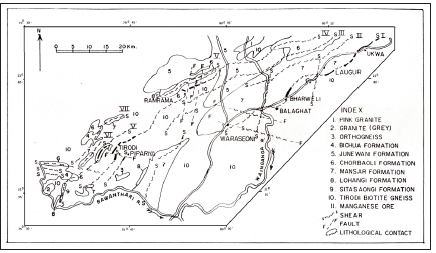
In a much recent work, Banerji et al. [13,15] however, contradicted that the Sausar rocks of the area do not preserve any sedimentary structure that can ascertain top and bottom of the rocks. They also opined that the biotite gneisses (Tirodi gneiss and Junewani gneiss) are products of synkinematic emplacement of white feldspar bearing granitic material within the pre-existing carbonate dominated sediments. They suggested that the calc-silicates associated with the Sausar Group are metasomatic skarns and the rocks like marble, biotite schists, biotite granulite and calcareous phyllite are metamorphic products, lacking evidences towards direction of younging, and occur intricately associated with the synkinematic granitic emplacements.
Tight, isoclinal to recumbent, folding along NE-SW to ENE-WSW axial trend represents first phase of folding and produces S1 schistosity in the Sausar rocks. Refolding of F1 folds along shallow dipping (300), co-axial but non co-planar , S2 cleavages produces F2 isoclinal folds Banerji et al. [14,15] NW-SE to WNW-ESE trending open warps with steep (700) northerly plunges represent last phase of folding.
Banerji et. al. (op.cit.) also reported presence of a series of sinuous mylonite zones in Balaghat Sausar belt Figure 1, running parallel to S1 schistosity and having a well-developed mylonitic foliation, parallel to the shear zone boundary. These weak zones represent ductile to semi brittle deformation. All the major manganese deposits of the area are reported to have epigenetically emplaced within these mylonite zones.
Manganese Mineralization
Manganese mineralization associated with Sausar Group of rocks has been considered as metamorphosed syngenetic type, owing to their intimate association with quartz-muscovite schists of Mansar Formation, and co-folding with these schists. Interbanding of the ore bands with quartzose layers has been taken as supportive evidence towards sedimentary layering representing primary bedding. The fact that the Bharweli and Ukwa deposits are hosted within Mansar phyllite, in close association with muscovite/sericite schists, needed no further explanation towards their being sedimentary. In contrast, Ramrama, Tirodi and Sukli-Sitapathore deposits occur as narrow, repeated, bands hosted within ‘Tirodi biotite gneiss’, again in close association with thin layers of quartz-mica schists. These deposits, therefore, are considered to have deposited within long, narrow, depositional furrows formed within the basement ‘Tirodi gneiss’, omitting other members of the Sausar Group.
All these deposits are represented by manganese oxides like hausmanite, vredenburgite, jacobsite, braunite, hollandite and bixbyite. Intergrowth texture between braunite and bixbyite, and between hausmanite and jacobsite and inclusion of vredenburgite in braunite and also of hausmanite in vredenburgite are some of the common micro features associated with these deposits. Occurrence of high temperature oxide ores (hausmanite, vredenburgite, jacobsite, braunite) within the Mansar phyllite dominated low grade terrain of Bharweli-Ukwa, and their intergrowth textures, have been explained to be the resultant metamorphic effects on the syngenetic manganese.
A fresh look into the occurrences of these manganese deposits, however, point to certain startling features which compel to revisit the hitherto put forth explanations towards origin of the manganese deposits of this belt. The important outcomes are as described in the following paragraphs.
Figure 2: Satellite image showing curvilinear extension of Sukli-Stapathore Mn ore body.
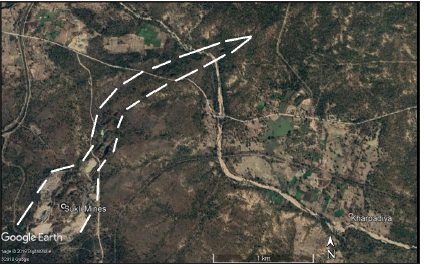
Figure 3: Satellite image showing curvilinear extension of Mn ore bodies at Tirodi.
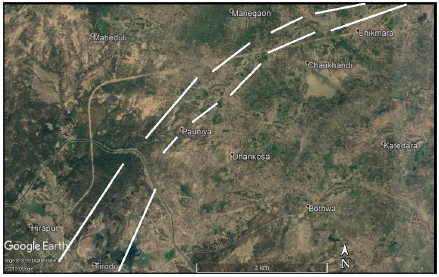
It is observed that the manganese deposits of this belt are invariably aligned along one or the other high strain zones, characteristically having a layered arrangement of minerals. The ENE-WSW trending sinuous, folded, mylonite zones came into being during late D1 deformation and are affected by D2 and D3 deformations Banerji et al. [14]. Association of the Sukli-Sitapathore Figure 2, Tirodi Figure 3, Bharweli Figure 4 and Ukwa Figure 5 deposits with these mylonite zones are very glaring in satellite images. Mylonite zone hosting manganese deposits of Ramrama, is later affected by repeated N-S faults. Association of autoclastic conglomerates, conforming progressive shear deformation, with the mylonite zones of Ramrama and Bharweli - Gangulpara is also discussed by Banerji et al. [15].
Figure 4: Satellite image showing part of the curvilinear mylonite zone extending from west of Balaghat through Manegaon (Bharweli), Gangulpara and jagantola to Ukwa and beyond.
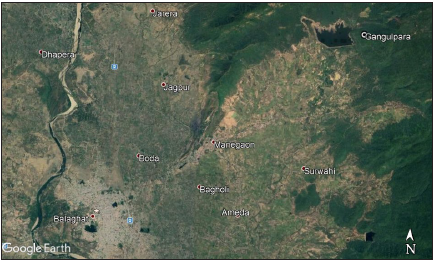
Figure 5: Satellite image showing curvilinear extension of ore zone at Ukwa.
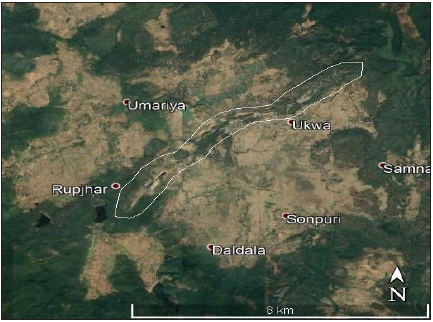
Parallel orientation of the ore bands along the regional trend (S1), showing colour banding, raises least doubt towards a syngenetic origin of the ores. However, their selective association with the curvilinear mylonite zones is alarming and compels to think about other possibilities towards their mode of origin.
The quartz and manganese interbands, giving an impression of colour banding/sedimentary layering, are co-axial but non-co-planar to S1 schistosity. At Bharweli, footwall of an abandoned quarry Figure 6, where an opening was being made for further underground mining, revealed many features contradicting the general acceptance towards the ore being syngenetic. The walls of the south facing opening Figure 7 exhibit association of alternate layers of quartz and manganese ore with the host Mansar phyllite. The regional foliation represented by S1 foliation shows a northerly dip of 500 to 600 within phyllite. The S1 foliation of the phyllite is, however, intersected by steep northerly dipping shear planes (SH) and the shear parallel layers of quartz and manganese ore, present on either side of the band of phyllite. This relationship clearly indicates that the ore interbands and the shear planes are later to the S1 Schistosity. The S1 schistosity and the shear planes (SH) along with the associated ore interbands are further intersected by shallow (300-400) dipping S2 planes, producing kinks on S1 and SH planes. This kink on earlier planes is further strong and taking shape of folds (F2), elsewhere on the same footwall Figure 8. The footwall also shows pseudo ripples Figure 6 produced due to interference of F2 and F3 folds, producing dome and basin structures on mesoscopic scale.
Figure 6: Pseudo ripples produced by interference of F2 and F3 folds on intercalated Mn ore body. Loc. Abandoned quarry, Bharweli Mines.
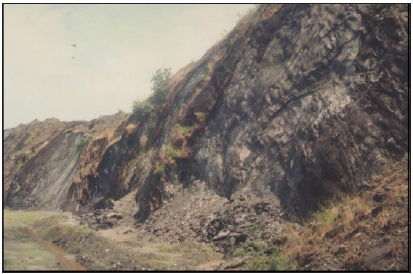
Figure 7: Traces of shear planes (SH) within phyllite, hosting shear parallel manganese ore bands. Please note the superimposition of SH over S1, and also of S2 cleavages over all the earlier planes. Loc. Bharweli Mines.
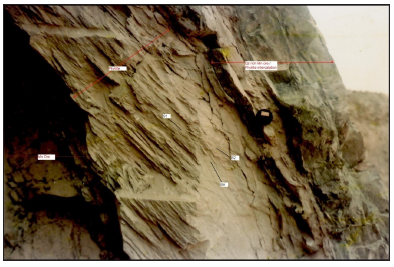
Figure 8: F2 folding of the phyllite-Mn ore intercalations. Loc. Bharweli Mines.
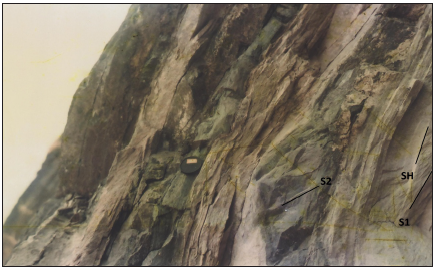
Similar features are observable in Ukwa deposits where dip of S1 plane is very shallow (250-300) while the shear planes, hosting manganese mineralization, dip 350-400 in the same direction Figure 9.
Figure 9: Angular (non co-planar) relationship between S1 schistosity and shear planes (SH). Loc. Ukwa Mines.

In the biotite gneiss hosted manganese deposits of Ramrama, Tirodi and Sukli-Sitapathore, where the manganese is believed to have deposited in narrow furrows with thin envelope of quartz-mica schists, the ore bodies exhibit pinch and swell nature and, at many a places, observed to have emplaced as tongues directly within biotite gneiss Figure 10. The pinch and swell nature, with swerving around foliation of the host gneiss, is very clear towards lateral margins of the ore bodies, as seen in foot/hanging walls Figure 11 and also in strike extension, at the end part of the active mines. Incidentally, pinch and swell phenomenon can also be witnessed near the southern end of Bharweli mines, where the NE-SW ridge, north of the Bharweli approach road, occupied by Mansar phyllite, exhibit numerous small pods of manganese ore bodies with swerving around S1 schistosity of phyllite.
Figure 10: Pinching and swelling of Mn ore band within biotite gneiss. Loc. Northern end of Tirodi Mines.
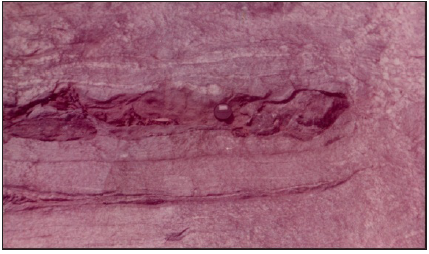
Figure 11: Bulging of Mn ore bands within wall rock of felspathised biotite gneiss. Also, note the swerving around of the foliation at the periphery of ore lenses. Loc. Tirodi Mines.
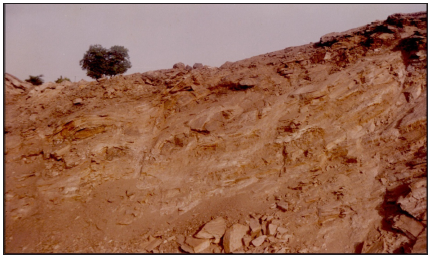
Close association of calc-silicates with the biotite gneiss hosted deposits are also noteworthy. The manganese silicate rock ‘Gondite’ also makes a close association with the biotite gneiss hosted deposits. Sukli-Sitapathore deposit, present at the western extremity of the belt, exhibit best example of the association of calc-silicates, present as enclaves within the host biotite gneiss, and the ‘Gondite’ occupying the peripheral part of the ore lenses. The quartz rich peripheral part of the ore zones, having proximity to calc-silicates, contains pockets rich in asbestos.
Towards the end of the active mines, the ore lenses become progressively lean, and extend for few kilometers in strike continuity. The Sukli-Sitapathore deposit extend for around 3kms with a sinuous trend and traceable as pods of 1m - 2m size within sheared and felspathised ‘Tirodi gneiss’ exposed in Dhoriya Nala (210 41’ : 790 41’). Similar habit is exhibited by the Tirodi ore deposit which extends for around 6kms, and splits into thin lenses, before final disappearance. Ramrama deposit, likewise, exhibits similar pattern and is further disturbed by later displacements along N-S trend. The ore bodies at these deposits also exhibit cross cutting relationship with the host biotite gneiss Figure 12.
Figure 12: Cross cutting relationship of the Mn ore lenses with the host biotite gneiss. Loc. Tirodi Mines.

The ore bodies comprise manganese-oxides like braunite, bixbyite and hollandite as essential constituents of all the deposits. In addition, the biotite gneiss hosted deposits contain jacobsite, hausmanite and vredenburgite. Intergrowth textures between braunite and bixbyite, and between hausmanite and jacobsite along with the inclusion of vredenburgite in braunite and hausmanite in vredenburgite is well known. All these features of the ore bodies are indicative of a high temperature regime of deposition, and in presence of other supportive evidences, as described above, a hydrothermal mode of origin explains all the intriguing features those, otherwise, needed complicated processes to establish the deposits as syngenetic. Roy [7] carried out illustrative work on petrographic analysis of these deposits. However, preferred, dimensional orientation of the ore minerals along “S” and “C” planes, indicating ductile shearing of the ore zones, was first reported by Banerji et al. [14]. Remarkably, all the deposits exhibit preferred orientation of the ore minerals, and also of the accessory minerals like apatite, tourmaline, mica fishes and quartz, along “S” and “C” planes Figure 13a and Figure 13b. Also, it needs to be pointed out that Figure 13 of Roy [7], on closer examination, reveals preferred orientation of the constituent minerals/opaques.
Figure 13a: Photomicrograph showing preferred orientation of manganese opaques, quartz, apatite and tourmaline along “S” and “C” planes. Crossed nicols, X32. Loc. Ukwa mines.

Figure 13b: Photomicrograph showing preferred orientation of manganese opaques and accessories. Crossed nicols, X32. Loc.Ukwa mines.

The ore bodies occur interlayered with quartzose bands and these interlayered ore bodies, in turn, are embedded within quartz-mica schists/gneiss in all the deposits. It is also a fact that the thickness of the micaceous envelope is directly proportional to the thickness of the ore zone. Thicker ore lenses have better developed quartz-mica envelope, while the thinner bands have negligible presence of micaceous envelope. At the same time, the host biotite gneiss or the phyllite is invariably felspathized along the contact. Muscovite dominates over biotite in biotite gneiss of the contact zone. The gneiss also exhibits enrichment in altered potash feldspars. Phyllite, along the contact of ore bodies, is richer in sericite and altered potash feldspars, and the rock invariably is rendered pinkish sericite phyllite.
Figure 14: Breakdown of feldspar (K) into muscovite (m) and quartz (Q). Crossed nicols, X32. Tirodi.

Quartz-mica schists of the contact zone comprise quartz, muscovite, chlorite, sericite, altered potash feldspars, and accessory amount of garnet, tourmaline, apatite, kyanite, fibrolite and opaques. Muscovite and sericite appear to be alteration products of potash feldspars Figure 14. Occurrence of clusters of tourmaline Figure 15 along fractures of quartz grains, in all the manganese deposits, is indicative of boron metasomatism in these high strain zones. Muscovitisation/sericitization of feldspars, boron metasomatism, and the presence of chlorite in association of fibrolite indicate griesening along the ore zones Reilly [19], resulting finally into the formation of quartz-mica schists representing ‘Greisen’. The associated quartz is often stretched, and the opaques are dimensionally oriented along “S” and “C” planes, indicating progressive ductile deformation along the mylonites. Occurrence of well-developed and oriented crystals of tourmaline, apatite and fibrolite in the ore zones, is also indicative of existence of a stress field.
Figure 15: Clustering of tourmaline needles along fractures of quartz grains. Plane polarised, X32.

Interestingly, the “Mn-Fe-(Ni+Co+Cu) X 10 plots” of Bonatti et. al. and Crear et.al. [20] for all the manganese deposits of Balaghat belt, fall in the hydrothermal region. This clearly is corroborative with the present finding that the manganese ore bodies are emplaced along late D1 mylonites, as hydrothermal bodies. However, in absence of any theory towards hydrothermal origin for the manganese deposits of Balaghat, Nayak et.al. (op.cit.), had to depend on the age old syngenetic theory and concluded that the plotting of their samples in hydrothermal field was because of the deposition of the ore bodies, as “hydrothermal exhalatives”, under sub-marine conditions.
Discussion and Conclusion
Hydrothermal emplacement of manganese ore bodies, along weak zones, has been advocated for granite hosted New Ross manganese deposits of Canada [19], and for the phyllite hosted, strike parallel, Northern Nigerian manganese occurrences [21].
Restrictive occurrences of the manganese deposits of Balaghat within the mylonites, their being co-axial but non co-planar to the S1 schistosity of the country rock, presence of shear planes parallel to the ore bodies, and co-folding of the ore bodies and the shear planes along S2 and S3 axial traces, fixes the timing of shearing and emplacement of ore bodies, and points to the fact that the Sausar rocks were affected by co-axial (S1) but non co-planar shearing and hydrothermal emplacements during late D1 deformation.
The manganese ore bands, in granite hosted deposits, penetrate the wall rocks as tongues and apophyses, characteristic of hydrothermal deposits. Bulging of ore lenses with swerving around of foliation of biotite gneiss along with boudinaging of the lenses strongly indicate emplacement of tongues of ore bodies in the country rock, in a high strain regime. Pink felspathization of the biotite gneiss along the contacts indicate that the hydrothermal emplacements were also rich in potash.
Banerji et al. [14,15] reported occurrences of quartz-muscovite/sericite schists, with well cleaved and sheared quartzose core, characteristically associated with all the high strain zones identified by them. These well cleaved quartzose rocks, with or without manganese mineralization, exhibit a layered arrangement of minerals. Likewise, the manganese deposits associated with these high strain zones, also have a quartzose core alternating with layers of manganese ores. Peripheral zones of such quartz-manganese core are occupied by felspathic muscovite/sericite schists in biotite gneiss host, and by felspathic sericite-phyllite in phyllite hosts, respectively, having enrichment of altered pink feldspars, chlorite, tourmaline, apatite and fibrolite.
The fact that the ore bodies occur in high strain zones is evidenced by stretching and dimensional orientation of quartz, opaques and other constituents along ‘S’ and ‘C’ planes of mylonites. Occurrence of well-developed and oriented crystals of tourmaline, apatite and fibrolite in the ore zones, is also indicative of existence of a stress field. In addition, occurrence of clusters of tourmaline along fractures of quartz grains, in all the manganese deposits, is indicative of boron metasometism in these high strain zones. Banerji et al. also advocated for widespread griesening along the manganiferous/non manganiferous emplacements of the mylonite zones. The quartz-mica schists/gneisses rich in tourmaline, apatite, chlorite, and fibrolite, occurring in the peripheral part of the emplacements, are advocated to be the product of pneumatolysis.
The occurrence of high temperature oxide ores with intergrowth texture even in the low grade terrain of Bharweli-Ukwa, therefore, may not be because of metamorphism. The mismatch of temperature conditions, rather, is supportive of emplacement of the ore bodies under hydrothermal conditions, well supported by boron metasomatism and greisening along such zones. Plotting of the manganese samples in hydrothermal field of “Mn-Fe-(Ni+Co+Cu) X 10 plots”, as reported by Nayak et.al. (op.cit.) is further supportive of hydrothermal emplacements of the ore bodies along the weak planes.
These weak planes/late D1 shears, accompanied by progressive shear movement, were occupied by manganese bearing hydrothermal emplacements, related to late D1 pink feldspar magmatism (Banerji et. al. [14,15]. The mylonites, along with the hydrothermal emplacements/ore bodies, later got affected by D2 and D3 deformations, producing a sinuous map pattern of the mylonites, and the interference between F2 and F3 folds produced dome and basin structures, simulating ripple marks on mesoscopic scale.
The hydrothermal hypothesis, negating the earlier theory of selective deposition of manganese ores within the narrow furrows of biotite gneiss, satisfactorily explains the ore bodies as emplacements within biotite gneiss, accompanied by felspathization and pneumatolysis.
Possibility exists that the ‘Gondites’, present along the peripheral part of the biotite gneiss hosted deposits, are resultant product of reaction between manganese oxides and the felspathic component available within manganese bearing hydrothermal fluids. Presence of plenty of manganese silicates like winchite and spessartite within later pegmatites, intruding ore zones, support this hypothesis. Close association of calc-silicate lenses with the ore bodies, and the enrichment of ‘Ca’ within manganese silicates of ‘Gondite’, also indicate the possibility of participation of calc-silicates in the formation of ‘Gondites’. Presence of asbestos fibres within the biotite gneiss hosted deposits is further indicative of breaking down of higher silicates of the calc-silicates into hydroxyl silicates, during this process.
It is evident, therefore, that the late D1 shears of the Balaghat belt were preferentially occupied by hydrothermal fluids, related to late D1 pink magmatism (Banerji et al. [15]. The hydrothermal fluid was either rich in residual manganese, as proposed by Reily [19] for the New Ross Mn deposits of Canada, or it scavenged manganese oxides from the silicates rich in manganese. Widely occurring calc-silicates could also prove to be a storehouse for such manganese silicates.
References
- Fermor, LL (1909) The manganese ore deposits of India. Mem Geol Surv 37(4): 613-1287.
- Straczek JA, Narayanaswami S, Subramanyam MR, Shukla KD, Vemban NA, et al. (1956) Manganese ore deposits of Madhya Pradesh, India. 20th Int Geol Cong, Mexico Session, Symposium on Manganese, Mexico, 4: 63-96.
- Roy S (1958) Mineragraphic study of the manganese ores of Tirodi, Balaghat district, Madhya Pradesh, India. Proc Nat Inst Sci 24A(1): 89-99.
- Roy S (1962) Study of the metamorphic manganese ores of Bharweli mine area, Madhya Pradesh, India, and their genesis. Econ Geol 57(2): 195-208.
- Roy S (1964a) Genesis of manganese ore deposits of Madhya Pradesh and Maharashtra, India. Proc 22nd Int Geol Congr, 5, Genetic problems of ores, pp. 199-214.
- Roy S (1964b) Mineralogenetic trend with regional metamorphism in the manganese ore deposits of Madhya Pradesh and Maharashtra, India. Proc. 22nd Int Geol Congr, 5, Genetic problems of ores, pp. 493-509.
- Roy S (1966) Syngenetic manganese formations of India. Jadavpur University, Calcutta.
- Roy S (1970) Studies on manganese bearing silicate minerals from metamorphosed manganese formations of India I Juddite. Min Mag 37(290): 708-716.
- Roy S (1980) Geology and geochemistry of manganese. Vol II, Manganese deposits of continents. Akademiai Kiado, Budapest, pp. 236-264.
- Subramanyam MR (1972) The geology and manganese ore deposits of the manganese belt in Madhya Pradesh and adjoining parts of Maharashtra. Part IV - The geology and manganese deposits of the Ramrama - Sonawani area, Waraseoni Tehsil, Balaghat district and parts of Seoni Tehsil, Chhindwara district, Madhya Pradesh. Bull Geol Surv Ind Ser A Vol. 22.
- Shukla KD, Anandalwar MA (1973) The geology and manganese ore deposits of the manganese belt in Madhya Pradesh and adjoining parts of Maharashtra. Part VIII - The geology and manganese ore deposits of the Balaghat-Ukwa area, Balaghat district, Madhya Pradesh. Bull Geol Surv Ind Ser A Vol. 22.
- Vemban NA, Nagarajaiah RA (1974) The geology and manganese ore deposits of the manganese belt in Madhya Pradesh and adjoining parts of Maharashtra. Part V - The geology and manganese ore deposits of the Tirodi area, Northern Balaghat district, Madhya Pradesh. Bull Geol Surv Ind Ser A 22: 9,13 &14.
- Banerji DC, Shrivastava RK, Fulmari M, Singhai RK, Devrajan MK, et al. (1996) Final report on special thematic mapping of Sausar belt in parts of Balaghat and Seoni districts of Madhya Pradesh. Geol Surv Ind unpublished progress report.
- Banerji DC, Majumder S, Singhai RK, Shrivastava RK, Fulmari M (2007) Manganese mineralization associated with folded shear zones in Balaghat district, Madhya Pradesh. Jour Eco Geo and Georesource Management 4(1-2): 128-141.
- DC Banerji, S Majumder, RK Shrivastava, M Fulmari, AK Basu (2019) Hierarchy amongst rocks of sausar group -Evidences from seoni-balaghat area, Madhya Pradesh, India. Archaeology & Anthropology: Open Access 3(4): 515-534.
- Narayanaswamy S, Venkatesh V (1971) The geology and manganese deposits of northern Bhandara district, Maharashtra. Bull Geol Surv Ind Ser A 22(4).
- Pascoe EH (1950) A manual of the geology of India and Burma (3rd edn), Vol. 1.
- Narayanaswamy S, Chakravarty SC, Vemban NA, Shukla KD, Subramanyam MR, et al. (1963) The geology and manganese ore deposits of the manganese belt in Madhya Pradesh and adjoining parts of Maharashtra. Bull Geol Surv Ind Ser A 22(1).
- Reilly GAO (1992) Petrographic and geochemical evidences for a hypogene origin of granite hosted, vein type Mn mineralisation at the New Ross Mn deposits, Lunenberg country, Nova Scotia, Canada. Econ Geol 87: 1275-1300.
- Nayak B.K, Acharya B.C, and Sahu R.K (1995) Factor model for the genesis of manganese deposit, Balaghat, M.P. Jour. Geol, Soc. Ind. 46: 65-73.
- Mucke A, Okujeni C (1984) Geological and ore microscopic evidence on the epigenetic origin of the manganese occurrences in northern Nigeria. Journal of African Earth Sciences 2(3): 209-225.
© 2020 Banerji DC. This is an open access article distributed under the terms of the Creative Commons Attribution License , which permits unrestricted use, distribution, and build upon your work non-commercially.
 a Creative Commons Attribution 4.0 International License. Based on a work at www.crimsonpublishers.com.
Best viewed in
a Creative Commons Attribution 4.0 International License. Based on a work at www.crimsonpublishers.com.
Best viewed in 







.jpg)






























 Editorial Board Registrations
Editorial Board Registrations Submit your Article
Submit your Article Refer a Friend
Refer a Friend Advertise With Us
Advertise With Us
.jpg)






.jpg)














.bmp)
.jpg)
.png)
.jpg)










.jpg)






.png)

.png)



.png)






